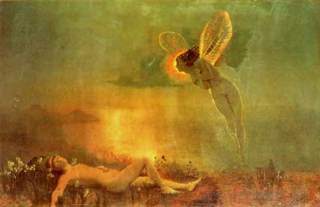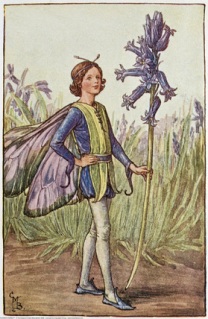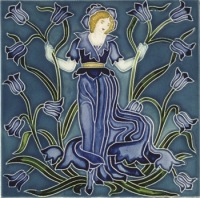 |
| last year's bluebells |
I live close to Hirst Wood where you can normally do a bluebell walk at this time of year. The bluebells are late this Spring, in Yorkshire at least so there's nothing for it but to seek the flowers in books and stories.
Bluebells have always figured large in European folklore and fairy tales. Known by various names, including the fanciful witch’s thimble, one of their scientific moniker is Endymion non-scriptus. In Greek Mythology, Endymion was a handsome shepherd or, in some versions of the myth, a hunter. Selene, the moon goddess fell hopelessly in love with him and begged Zeus to keep him young and asleep forever, so that she could admire him from the sky. Zeus granted her wish, and Endymion fell into a deep sleep from which he never awoke. In the past, bluebells were believed to be so intoxicating, their perfume made anyone who walked into a field of them fall asleep. Hence the connotation in the Latin name.
 |
| Endymion and Selene, by Victorian artist J. A. Grimshaw |
The idea of bluebells sending people to sleep also pervades Native American folklore. In a popular fable, a hummingbird and a crane race each other, much like the hare and the tortoise in the renowned fable by Aesop. Hummingbird, being small and light on her wings, assumes she will win – so she stops for a rest in a patch of bluebells. With unfortunate results!
Woods have always been considered enchanted places in the collective imagination. They are dark, mysterious realms which teem with unseen forces and magic beings. As bluebells grow mostly in the woods, they have been associated with fairies, and woodland creatures. In The Fairy Caravan, Beatrix Potter’s only chapter book, which is inspired by Celtic folktales, the author describes wild dwarfs called oakmen living in a forest full of bluebells. In other European tales, unwary travellers wander into clearings full of bluebells, often encountering fairies, or incurring their wrath. Popular legend had it that blundering into a patch of bluebells broke the fairy spells hung on them to dry.
 |
| The Bluebell Fairy – C. M. Barker |
Fairies were believed to be summoned for midnight revelries by the pealing of bluebells. But beware the hapless mortal who hears the sound. He will die by morning. Unless, of course, the fairies had rung the bluebells to summon him. Which does happen a few times in fairytales.
In a German folktale, a goldsmith and a tailor travelling along a country road are lured into the woods by the enchanted sound of bluebells ringing in the breeze. The music leads them to a group of dancing fairies, who ply them with treasure teach as well as teaching them the importance of not being greedy.
Some country folk considered growing bluebells in your own garden, or bringing a bunch of them indoors, incurred the ire of the fae folk. They would be dogged by bad luck. Others thought clumps of bluebells outside the front door brought good luck, and tinkled to warn when unwanted visitors approached the front door. Wearing a bracelet of fresh bluebells around your ankle, especially on the eve of Beltane, summoned the good fairies to protect you.
Such beliefs, of course, died a long time ago. But the association between bluebells and fairies remains in folktales and literature. Here is a sweet poem that I learnt as a child, and has endured the test of times:



9 comments:
Lovely post, and gorgeous illustrations, especially that tile.
Thanks, Sue. Just added a pic of Hirst Wood.
Saviour - that a charming prince of a post - thank you for colouring my day with bluebells. I haven't seen that Walter Crane tile before - I'd like a wall of those :D
(p.s. Have you seen 'A Treasury Of Great Children's Book Illustrators by Susan E. Meyer? Walter Crane's "Beast" is a beauty)
A carpet of bluebells is always stunning. I'm just glad to hear those superstitions have died out - I just planted a gardenful.
I love the notion of fairy spells hanging on bluebells to dry. Thank you for sharing. I love the tile and the Emily Bronte poem. Hope your mishap at the gym wasn't caused by you blundering into a field of bluebells!!
Such a pleasure to read this post, As soon as I started reading, I thought of the Flower Fairy books - and scrolling down, there was the picture, with such a beautiful tile further down.
I was wondering about one of our local bluebell woods only yesterday but those in my garden are still only masses of green leaves.The scent of a bluebell wood - as your stories show - can feel quite intoxicating and more marvellous as individuallythe flowers don't seem to have that much scent.
In Helston in Cornwall we are allowed to pick bluebells to decorate the town for the Flora Day dance on the 8th May. This combined with the sharp and intoxicating scent of yellow gorse make a heady combination of colour and smell. Lots of other flowers and greenery are added in but the bluebell and gorse are the main players.
No wonder a walk in bluebell wood always feels such a magical experience...thanks for all that enlightenment.
Lovely post and pictures, Saviour. And, Yorkshire people, your bluebells will surely be with you soon. They are out in abundance here in Shropshire.
Post a Comment